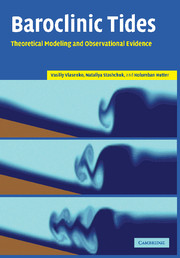Book contents
- Frontmatter
- Contents
- List of tables
- Preface
- Acknowledgements
- List of symbols
- List of abbreviations
- Preamble
- 1 General background
- 2 Linear baroclinic tides over variable bottom topography
- 3 Combined effect of horizontal density gradient and bottom topography on the dynamics of linear baroclinic tides
- 4 Topographic generation of nonlinear baroclinic tides
- 5 Evolutionary stages of baroclinic tides
- 6 Generation mechanism for different background conditions
- 7 Three-dimensional effects of baroclinic tides
- References
- Index
Preamble
Published online by Cambridge University Press: 14 August 2009
- Frontmatter
- Contents
- List of tables
- Preface
- Acknowledgements
- List of symbols
- List of abbreviations
- Preamble
- 1 General background
- 2 Linear baroclinic tides over variable bottom topography
- 3 Combined effect of horizontal density gradient and bottom topography on the dynamics of linear baroclinic tides
- 4 Topographic generation of nonlinear baroclinic tides
- 5 Evolutionary stages of baroclinic tides
- 6 Generation mechanism for different background conditions
- 7 Three-dimensional effects of baroclinic tides
- References
- Index
Summary
The World Ocean, considered as an active dynamical system, is in permanent motion. Most of its manifestations can be related to wave phenomena. Besides the well known surface waves, there are also waves of other nature; among these, internal gravity waves are particularly important. They exist due to the presence of vertical fluid stratification, they are permanently generated, and they evolve and are destroyed again in the deep ocean. The amplitudes of internal waves are usually much larger than those of surface waves, due to the weak returning force, and their amplitudes can sometimes reach values of 100 m and more (see refs. [5], [23], [120], [128], [180], [192], and [193]).
Numerous in situ measurements, carried out in all regions of the World Ocean (see, for instance, refs. [63], [119], [123], and [157]), have shown that internal gravity waves exist wherever a stable vertical stratification of a fluid is observed. They were discovered more than 100 years ago, and were understood by the scientists of the day to be a disappointing obstacle disturbing the “correct” structure and dynamics of the oceanic water masses. More than half a century passed before the importance of internal waves to the global dynamics of the ocean was realized.
- Type
- Chapter
- Information
- Baroclinic TidesTheoretical Modeling and Observational Evidence, pp. 1 - 6Publisher: Cambridge University PressPrint publication year: 2005

